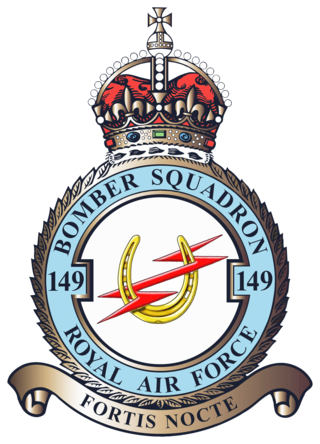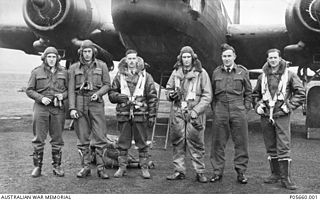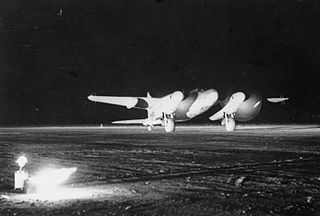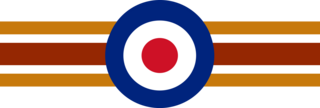
The Bristol Beaufort is a British twin-engined torpedo bomber designed by the Bristol Aeroplane Company, and developed from experience gained designing and building the earlier Blenheim light bomber. At least 1,180 Beauforts were built by Bristol and other British manufacturers.

No. 149 Squadron RAF was a Royal Air Force Squadron between 1918 and 1956. Formed 1918 in the Royal Flying Corps as a night-bomber unit, it remained in that role for the rest of its existence which spanned three periods between 1918 and 1956.

No. 489 (NZ) Squadron was a torpedo bomber squadron established for service during the Second World War. It was a New Zealand squadron formed under Article XV of the Empire Air Training Plan. Although many of its flying personnel were largely drawn from the Royal New Zealand Air Force, the squadron served in Europe under the operational and administrative command of the Royal Air Force as part of Coastal Command.

No. 603 Squadron is a squadron of the Royal Auxiliary Air Force, based in Edinburgh, Scotland. On reforming on 1 October 1999, the primary role of 603 Squadron was as a Survive to Operate squadron, as well as providing force protection.

No. 211 Squadron RAF was a squadron in the Royal Air Force active from 1917 to 1919 and from 1937 to 1946. In World War I it operated as a bomber and later a reconnaissance unit on the Western Front. In World War II it operated as a medium bomber unit in the Middle East and Far East and later as a strike fighter unit in the Far East, equipped with, successively, the Bristol Blenheim, the Bristol Beaufighter and de Havilland Mosquito.

No. 38 Squadron of the Royal Air Force was a bomber squadron formed in 1916 and was disbanded most recently in 1967.

No. 455 Squadron was a Royal Australian Air Force (RAAF) torpedo bomber squadron during World War II and became famous as part of the "ANZAC Strike Wing" that was formed from Australian and New Zealand squadrons. Raised in early 1941, mainly from Australian personnel, the squadron served over Europe during the war, operating from various bases in the United Kingdom; it also briefly sent a detachment to the Soviet Union in 1942. Operating Handley Page Hampdens and Bristol Beaufighters, the squadron mainly undertook anti-shipping and anti-submarine operations during the war. It was disbanded in May 1945 following the cessation of hostilities against Germany.

No. 458 Squadron RAAF was a Royal Australian Air Force squadron that operated during World War II. It was formed in Australia under Article XV of the Empire Air Training Scheme. The squadron flew various versions of Vickers Wellington bombers, first in Europe and later in the Middle East. It was disbanded in mid-1945, following the conclusion of hostilities in Europe.
No. 242 Squadron RAF was a Royal Air Force (RAF) squadron. It flew in many roles during the First World War, Second World War and Cold War.
No. 108 Squadron RAF was originally a squadron of the Royal Flying Corps during World War I which continued to serve with the Royal Air Force in World War II.

No. 217 Squadron RAF was a squadron of the RAF. It was formed and disbanded four times between 1 April 1918 and 13 November 1959. In World War I it served in a strike role against enemy bases and airfields in Belgium. In World War II as part of RAF Coastal Command it served first in a maritime patrol role along the Western Approaches and later in an anti-shipping role in the English Channel. Ordered to the Far East in 1942, the squadron was retained for two months in Malta in an anti-shipping role, protecting Allied convoys, before moving to Ceylon to defend the approaches to India, serving in an anti-submarine and anti-shipping role. It was equipped and training for a strike role, when the war ended. In the postwar period, it served for five years in a maritime reconnaissance role, and then briefly in a support role for Operation Grapple, the British hydrogen bomb tests on Christmas Island.

No. 256 Squadron RAF was a flying squadron of the Royal Air Force which operated during the First and Second World Wars. Initially equipped with Dh6 and Kangaroo aircraft, it operated Defiant Mk IIs, Beaufighters, and Mosquitoes in the Second World War.
No. 229 Squadron RAF was a squadron of the Royal Air Force, and is an officially accredited Battle of Britain Squadron. It became No. 603 Squadron RAF in January 1945.

No. 219 Squadron of the Royal Air Force was founded in 1918 and disbanded in 1957 after four separate periods of service. During the First World War it served as a coastal defence unit, and through most of the Second World War and the 1950s it operated as a night fighter air defence squadron. Three commanders of the squadron went on to be Chiefs of the Air Staff, two of the RAF and one of the Royal Pakistani Air Force.
No. 248 Squadron was a squadron of the Royal Air Force, active immediately after World War I, and again during World War II.

Number 125 (Newfoundland) Squadron was a Royal Air Force squadron active during World War II and briefly in the mid-1950s. Throughout its service the squadron primarily operated night fighters.
No. 123 Squadron of the Royal Air Force was a British aircraft squadron in the First and Second World Wars. It was disbanded for the last time on 20 June 1945.

No. 255 Squadron RAF was a Royal Air Force Squadron formed as an anti-submarine unit in First World War and a night-fighter unit in Second World War. The First World War squadron was formed from former Royal Naval Air Service coastal flights and was responsible for coastal anti-submarine patrols. It was disbanded after the war.
No. 272 Squadron RAF was a Royal Air Force Squadron formed as an anti–submarine unit in World War I and a coastal fighter unit in World War II.












